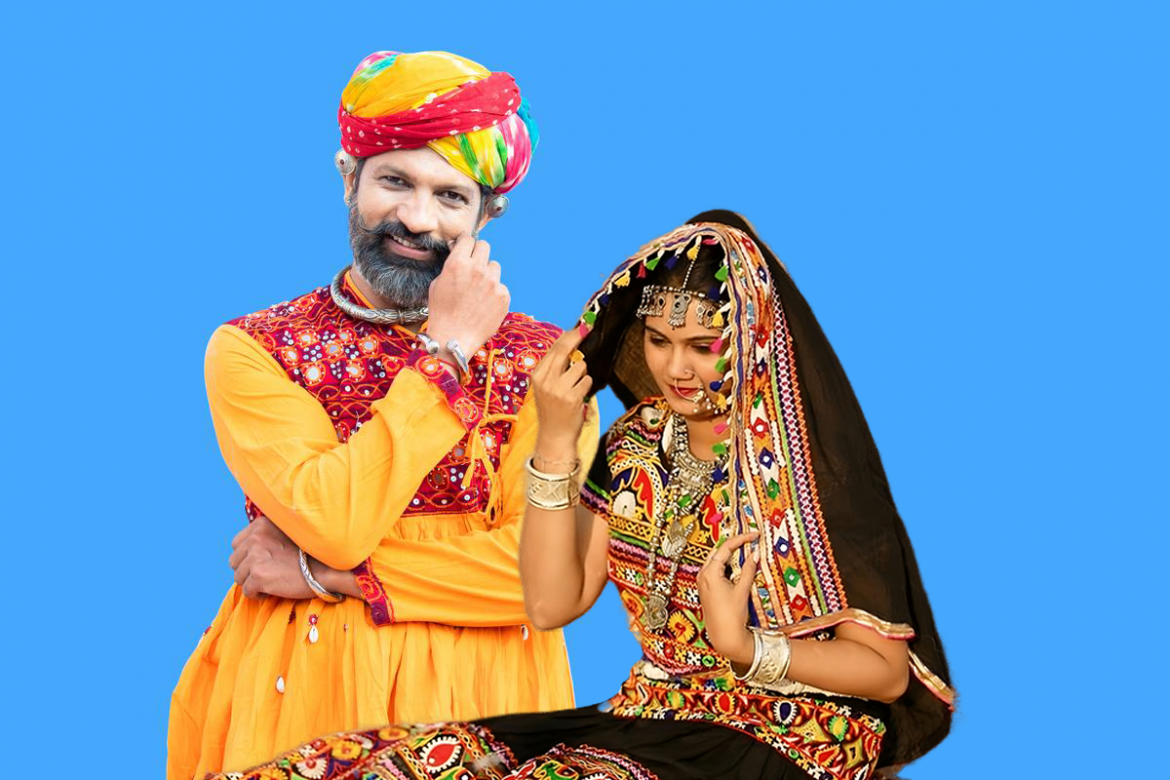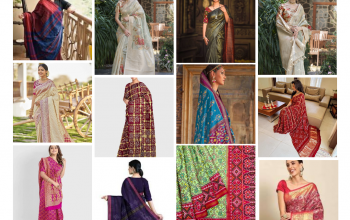The first and foremost thing that comes to mind while considering Gujarati attire is its distinct colorful Ghagra and choli and the famous ‘Garba’ dance. Gujarat is famous for its delicious cuisine, but it is also famous for its Bandhini cloth material and silk. Furthermore, Gujarat’s culture has been impacted by the growth of the fashion sector. People have begun to use the traditional designs on Kurtis and tops. That makes a combination of ethnic and western wear, or it is famously known as Indo-western attire. Gujarat’s weather has a significant impact on how its resident’s dress. Females decorate and beautify themselves with fashionable accessories, and expensive jewelry in addition to elaborate clothing.
Gujarat celebrates a wide variety of festivals. Navratri’s is the state’s biggest holiday. Flowers and lights are used to adorn several temples. Gujaratis go shopping for new attire and accessories on this day. Dance is performed all around the country during the nine-day holiday of Navratri. This unique dance, known as Raas Garba, is performed to dandiya music.
If you wonder, how does the authentic traditional garba look is? Or how do you dress up as a Gujarati man or woman? Keep on reading. You will find out how to dress like Gujaratis.
Wearable Ornaments
Both men and women wear lovely jewelry and accessories. Depending on the state’s geographical location, different fashion styles are prevalent. The textile pieces, delicate thread work, tiny patches, use of beads, and astar galas are typically present, giving the traditional Gujarati attire an added touch of elegance.
Chorno, a male undergarment
The traditional dress for Gujarati males is called a chorno. In rural places, cotton-made clothing is frequently worn. All around Chorno, little Angra Khus are worn to hide the upper portion of men’s bodies.
This would be one of the most well-liked and vibrant bottoms wear you could find if you searched the market for a Gujarati dress. Not that there aren’t any others, but people frequently purchase this due to its lovely handiwork and comfort. Men wear chornos, which are essentially embroidered dhotis.
It is designed with pure elegance and comfort. Men wear it at various events, including the most well-known festival or celebration called Dandiya Night. The string (Naada) or elastic used to fasten this outfit around your waist is quite loose and comfy.
The most popular men’s bottom garment is the dhoti.
Although it resembles a dhoti, chorno is more than that. However, this one is the one you often see. Although numerous modernized, elasticized, and other variations of Gujarati dhotis also exist. However, traditional clothing shows people wearing white or knotted dhoti in a genuine manner. In many regions of our country, the dhoti is still among men’s most popular bottom garments.
It has remained intact and has been a part of many civilizations. Not only that, but women also wear this clothing in various areas of our nation. And that is also now in style: young females sporting shirts and embroidered dhotis. Stitched dhotis are also worn with Kurtis. It is a trendy apparel currently for both men and women.
Phento: Stylish men’s headgear
Phento is a stylish and vibrant headpiece. It has long been a part of Gujarati culture. This is constructed by rolling a long fabric, wrapping it around the head, and tying it. Some claim that the headpiece used in the various regions of Rajasthan is where Phento got its name.
Today, it is common to observe Penton in Gujarat; if you still want to have a peek, head to the rural districts. You’ll see folks wearing Phento and authentic clothing at its finest.
Gujarati sarees are the ideal clothing for women
A saree is the most delicate female clothing, much like the dhoti is for males. We think you already know about this outfit. Therefore, there isn’t much of a difference. Because the practice of wearing a saree has become common practice throughout time, you may still go to Gujarat’s rural areas and see the difference. The second end of the saree, which is used as the Pallu, is brought and fastened at the front, which is one distinction you’ll notice.
Gujaratis have worn it in this manner for decades. And it seems lovely! Therefore, this is how you should wear a saree if you want to dress as a Gujarati woman.
Keviya
Male participants in the folk-dance dress in a Keviya, a tiny coat. The frilled pleats are used in the tight-sleeved coat’s design. Elegant embroidery is used on it. There is also a Churidar pajama, which is worn with an eye-catching turban. White keviya looks lovely with a decorated waistband. These outfits are also expensive. They can also be rented out to anyone for a short while. This traditional attire is frequently required to perform the folk dance.
The most attractive mirror work clothing is Chaniyo
Beauty of a Chaniyo, a women’s bottom attire, is challenging to convey. Although it also goes by the name “lehengas,” it is much more than that. In Chaniyo you have access to several patterns and styles. The one with mirror work, though, is the greatest of all. Most of these fashions are worn here during celebrations or festivals. Nevertheless, you may use this several times as they are trendy and gorgeous.
Girls and women are wearing it in various sections of the nation. Therefore, if you are too hesitant to purchase anything distinctive, you should choose this outfit and wear it with a choli and dupatta.
Choli: an embellished top
The blouse-like attire that ladies wear over lehengas and other similar garments are indeed what it is. Because it may be worn in various settings, choli is a trendy and adored garment in Gujarat. It is not only convenient and comfortable to wear and carry, but it also has a gorgeous appearance.
If there is an event or celebration nearby, you can still see many ladies wearing this in modern times. Furthermore, Cholis in Gujarat are adorned with exquisite embroidery and mirrorwork.
A complete Gujarati outfit is the ghagra choli
Another full costume made by Gujarati women; this one is currently worn widely across the nation. Women typically dress in Ghagra Choli, flowy bottom clothing embellished with hand and mirror work. Lehengas may be carried more efficiently and comfortably using a ghagra, a type of lehengas.
And a choli is what we have spoken about in the paragraph above. Combining the two of these is rather typical. And festivals and fairs will demonstrate that. Women adore wearing these dresses to show off their toned bodies, which undoubtedly look stunning and lovely. Don’t get confused with Chaniyo and Ghagra they both are a bit distinctive. Chaniyo designs are more traditional and they have A-line pattern unlike ghargra that have long cloth.
Kediyu: The top garment for guys

Gujarati males wear a traditional garment called a kediyu over a chorno, or you might say they are matched together. You may have noticed Gujarati males wearing the frok-like top on several occasions. It is a trendy and purely exquisite outfit that must be included in a list of traditional Gujarati wear.
Conclusion
Gujarat, an exciting and vibrant state, has significantly contributed to Indian culture. The Gujarati people are a thriving group due to their extreme simplicity and friendliness. Gujarat is home to vibrant works of art, architecture, culture, and legacy, all of which may be seen in the citizens’ day-to-day activities. The dressing style is just one aspect that expresses the Gujarati folklore and defines the people. The traditional wear of Gujarat is unique and distinctive. It has crossed boundaries and reached across the country. Many people love to dress in traditional ghagra-choli for Navratri.




